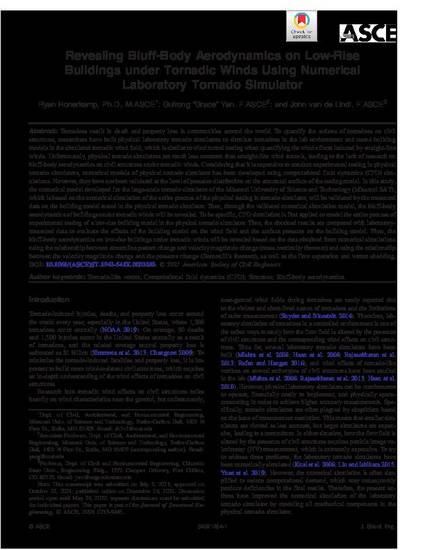
Tornadoes result in death and property loss in communities around the world. To quantify the actions of tornadoes on civil structures, researchers have built physical laboratory tornado simulators to simulate tornadoes in the lab environment and tested building models in the simulated tornadic wind field, which is similar to wind tunnel testing when quantifying the wind effects induced by straight-line winds. Unfortunately, physical tornado simulators are much less common than straight-line wind tunnels, leading to the lack of research on bluff-body aerodynamics on civil structures under tornadic winds. Considering that it is expensive to conduct experimental testing in physical tornado simulators, numerical models of physical tornado simulator has been developed using computational fluid dynamics (CFD) simulations. However, they have not been validated at the level of pressure distribution on the structural surface of the testing model. In this study, the numerical model developed for the large-scale tornado simulator of the Missouri University of Science and Technology (Missouri S&T), which is based on the numerical simulation of the entire process of the physical testing in tornado simulator, will be validated by the measured data on the building model tested in the physical tornado simulator. Then, through the validated numerical simulation model, the bluff-body aerodynamics of buildings under tornadic winds will be revealed. To be specific, CFD simulation is first applied to model the entire process of experimental testing of a low-rise building model in the physical tornado simulator. Then, the obtained results are compared with laboratory-measured data to evaluate the effects of the building model on the wind field and the surface pressure on the building model. Then, the bluff-body aerodynamics on low-rise buildings under tornadic winds will be revealed based on the data obtained from numerical simulations using the relationship between streamline pattern change and velocity magnitude change (mass continuity theorem) and using the relationship between the velocity magnitude change and the pressure change (Bernoulli's theorem), as well as the flow separation and vortex shedding.
- Bluff-body aerodynamics,
- Computational fluid dynamics (CFD),
- Structure,
- Tornado-like vortex
Available at: http://works.bepress.com/guirong-yan/52/

National Science Foundation, Grant 1455709